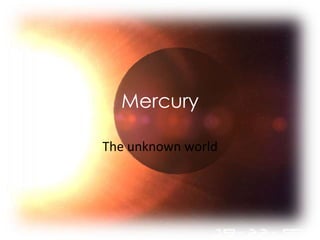
Mercury
- 2. Table of contents • Need to know • Landscape • Temperature • Mission to Mercury • Beautiful sunrise • Fast and fun facts
- 3. Mercury: Need to know • Part of our solar system • Mercury is the 1st planet from the sun (Closest). • It is a terrestrial or rocky planet (Like Earth). • Looks almost like our moon but has no moons of its own. • Known for its temperature changes. • No wind. • No water. • No oxygen. • No chance for alien life.
- 4. Mercury: Landscape Being the planet closest to the Sun, Mercury is embedded with craters from comets and asteroids pulled by the Sun’s gravity. The biggest crater is called The Caloris Basin; formed billions of years ago the impact of the object that struck Mercury was so powerful that shockwaves traveled through the entire planet and a jumbled, strange landscape on the other side of the planet is found where the Artist impression of the shock waves met. impact
- 5. Mercury: Temperature Being the smallest planet and the one closest to the sun gives Mercury a fiery reputation. During day Mercury temperature can raise to a searing 750°F (400°C) then at night can plunge to -290°F (-180°C). This is because of Mercury’s thin atmosphere letting the sun rays in and out easily, resulting in drastic temperature changes. On Mercury the sun shines 6 times more brightly then on earth and the because of the thin atmosphere the sky will be black.
- 6. Mission to Mercury Missions to Mercury have been limited, there has been only two spacecrafts that have voyaged to Mercury: 1. In 1974-1975 the probe Mariner 10 flew past Mercury tree times and photographed half the surface. 2. Then in August 2004 Messenger was launched to map the surface of planet Mercury and study the magnetic field and composition. Messenger is still active, orbiting Mercury.
- 7. Mercury: A beautiful sunrise If you are ever going to visit Mercury the thing is see is the sunrise: visit the solar systems smallest planet to see the biggest sun rise. The view of the sun on Mercury is practically 3 times bigger then seen on earth. If you are at the right place at the exact time you can see something astonishing that only happens on Mercury. A double sunrise! Since Mercury days are longer then its years, the Sun moves in an unexpected way. If seen from the exact location the sun will rise, dip back down and pop up again! This, although, is a painfully slow process that takes place over at least an entire month!
- 8. Mercury: Fast and fun facts Fast Fun • Diameter: 4,878km (3,032 Since a day (176 earth days) on miles) mercury is longer then a • Rotation period: 88 days year (86 earth days), every • Distance from the sun: 36 day on mercury you get two million miles (58 million km) years older! • Temperature: day: 750°F Mercury is part of the five (400°C), night: -290°F (- planets that can be seen 180°C). without a telescope. • Mass: 5.5% of Earth’s Mercury is named after the Roman god (messenger of • Moons: 0 the gods)
- 9. Mercury, The unknown world By: Olivia Thomas